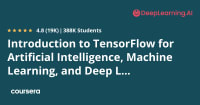Description
In this course, you will :
- Develop a deep learning-based algorithmic trading strategy.
- Use MetaTrader 5 and Python to implement any algorithm in live trading.
- Numpy, Pandas, and Matplotlib can be used to manage financial data.
- Pandas is used to clean data.
- Python programming is a programming language.
- TensorFlow 2.0 is used to implement deep learning.
- Deep Neural Networks must be understood and implemented (DNN).
- Recognize and apply Recurrent Neural Networks (RNN).
- Stock prices should be imported from Yahoo Finance and your broker.
Syllabus :
1. Python basics
- Type of object: Number
- Type of object: String
- Type of object: Logical operations / Boolean
- Type of object: Variable assignment
- Type of object: Tuple and list
- Type of object: Dictionary
- Type of object: Set
- Python structures: IF / ELIF / ELSE
- Python structures: FOR
- Python structures: WHILE
- Functions: Basics of function
- Functions: Local variable
- Functions: Global variable
- Functions: Lambda function
2. Python for data science
- Numpy: Array
- Numpy: Random
- Numpy: Indexing / Slicing / transformation
- Pandas: Serie and DataFrame
- Pandas: Cleaning and selection data
- Pandas: Conditional selection
- Matplotlib: Graph
- Matplotlib: Scatter
- Matplotlib: Toolbox
3. Import and manage the data
- Import & manage data from Metatrader 5
- Import & manage data from Yahoo Finance
4. Features engineering
- Get stock prices
- Create a simple moving average (SMA)
- Create a moving standard deviation (MSD)
- Use the Technical analysis library to compute the RSI indicator
- Automatization of the features engineering process
5. Deep Neural Networks apply to algorithmic trading
- Quick recap of the DNN theory
- Data import & Features engineering
- Train / Test set split (to fit the DNN model)
- Why and how to standardize the features
- Create a DNN using Tensorflow 2.0
- Use the DNN predictions to create a trading strategy
- Automate the process
- The stochastic initialization problem
- How to fix the stochastic initialization problem
- Bagging method using the different ANNs
6. Vectorized backtesting
- Sortino ratio computation
- Beta ratio computation (CAPM metric)
- Alpha ratio computation (CAPM metric)
- Drawdown: function creation
- Drawdown: application
- Backtesting function (1)
- Backtesting function (2)
- Backtest a trading strategy based on DNN
7. Recurrent Neural Networks for algorithmic trading
- Theory behind RNNs
- Recap from the DNN chapter
- How to transform 2-dimensional data into 3-dimensional data
- How to create a RNN using TensorFlow 2.0
- Dropout Layer
- RNN prediction to create a trading strategy
- Automate the process
- Find the best models throughout all the stochastic initialization
8. MetaTrader 5 live trading using Python
- Install a library on Jupyter
- Initialize the platform
- Get data broker
- Send orders on the market using Python
- Get current positions
- Run structure creation
- Close all positions
- Live Trading application: random signals
- Live Trading strategy based on ANN
- Live Trading strategy based on RNN









